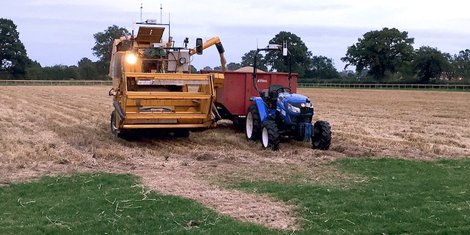Robotics and agricultural engineers at the Harper Adams University (UK) have been using open-source code to programme a fleet of connected autonomous vehicles and implements to carry out a variety of farming tasks—from sowing and fertilizing through weeding and field condition analysis, and beyond to the harvest. The underlying project named “Hands Free Hectare” resulted in the fully automated growing, tending and reaping of 4.5 metric tons of spring barley on a farm near the English village of Edgemont.
Several years ago, Jonathan Gill, mechatronic specialist at the Harper Adams University, pondered on the fact that although robotics and machine auto-guidance technologies for farming had been on the shelves for several years, no agri-tech company had yet come up with an integrated software platform for the full automation of the arable farming process. This is no longer a vision—at least for spring barley—with the potential to usher in a new era for agriculture.
 After securing a £200 000 grant from Innovate UK and Precision Decision, a smart farming company, Gill and his team of engineers set out to show that an arable farming cycle could be completed without any human setting foot on the land. The project relies on the interplay between machine guidance technologies (the remote driving of agricultural machinery from point A to B through GNSS signals) and robotics (the actuation layer of smart farming, where mechatronics enable the autonomous implementation of tasks at the right time, place and intensity).
After securing a £200 000 grant from Innovate UK and Precision Decision, a smart farming company, Gill and his team of engineers set out to show that an arable farming cycle could be completed without any human setting foot on the land. The project relies on the interplay between machine guidance technologies (the remote driving of agricultural machinery from point A to B through GNSS signals) and robotics (the actuation layer of smart farming, where mechatronics enable the autonomous implementation of tasks at the right time, place and intensity).
The catch lies in reprograming a drone autopilot open-source software and using it to run actuation protocols in the mechanics of basic analogous machines – namely an undersized 25-year old combine harvester, a Japanese tractor designed for rice paddies, and a basic spraying boom and seed drill. Once reconfigured by Gill and his team, the software could move the tractor’s steering wheel, control the sprayer’s nozzles, articulate the combine harvester and actuate the seed drill up and down. A GNSS system then enables the machines to follow a predefined field track. As for the crop sampling part of the cycle, the team used a clamshell hanging from a drone.
Automated arable farming: prospects and rationale
The successful harvest of one hectare worth of barley in the Edmonton farm this October signed the success of the project, and it could open up new perspectives for precision farming. The vision consists in getting farmers off their big tractors and turn them into managers of automated fleets of smaller, more agile machines. This would offer substantial benefits.
First, auto-guidance systems enable activities in the darkness, an important issue since many farming operations depend on the weather. This means that based on live forecasts, an autonomous tractor could go out and spray fertilizers during optimal conditions, even when it is 2am in the morning.
Second, substituting two-story high tractors that are commonplace today with autonomous fleets of small vehicles represents an important potential in terms of sustainability. In specific, lightweight fleets of small tractors could mitigate soil compaction. Furthermore, automated small agricultural machinery may optimize input application by spraying pesticides and fertilizers in a more targeted and precise manner.
For more information on the Hands Free Hectare project and automated farming, click here.